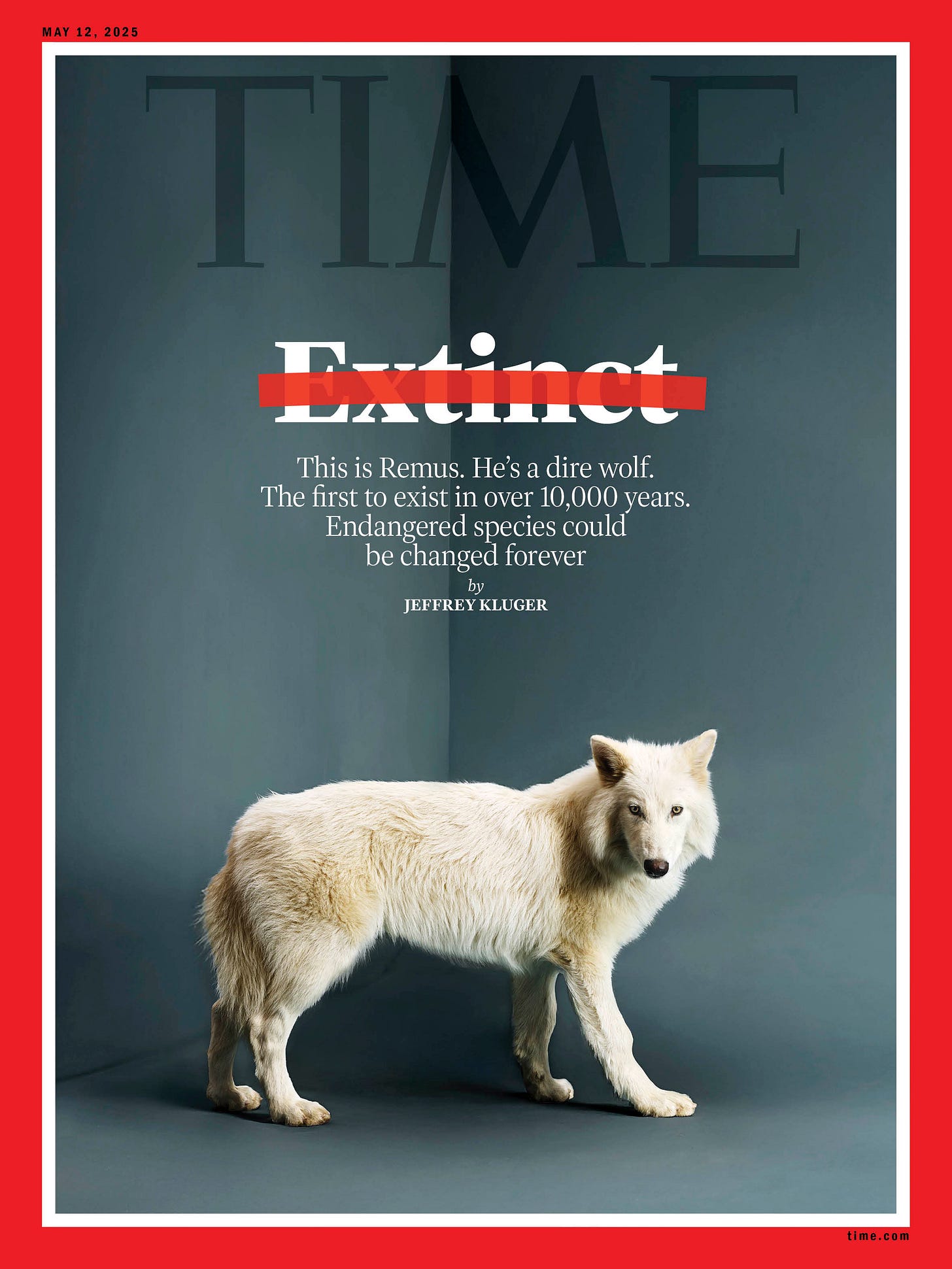Fake dire wolves; AI tariffs chaos; neuroimaging's big mistake; the ethics of seeding life in space, & more
Desiderata #34: links and thoughts
The Desiderata series is a regular roundup of links and thoughts for paid subscribers, and an open thread for the community.
Contents:
Real dire wolves, or genetic looks-maxxing?
Were we always in a semantic apocalypse?
Vibe governing: AI and the tariff equations.
A new documentary on consciousness.
Whoops, neuroimaging experiments don’t generalize!
Author buys cute church for $75,000… because he can.
Directed panspermia debate: Should we seed life across the galaxy?
From the archives.
Comment, share anything, ask anything.
1. Colossal Biosciences, a “de-extinction company,” has brought back dire wolves. You can listen to two of the pups, Romulus and Remus, howling here, and get a taste of the Paleolithic at night. TIME magazine published a detailed article yesterday announcing their return.
If we really could resurrect extinct species, I’d support it. While there are ethical considerations, none seem insurmountable. A zoo of living history would sure be something to bring my kids to. Call it Paleo Park—apropos of nothing, of course.
Beyond the jokes about “Winter is coming,” the real question is: are these just ersatz versions of the real thing? After all, they aren’t clones from dire wolf DNA, that’s too decayed; rather, gray wolf DNA was genetically engineered to more closely resemble dire wolves, and the embryos were implanted in and birthed by a domestic dog. Romulus and Remus (and their sister Khaleesi) have only had edits to 14 genes to make them different from gray wolves, while actual dire wolves had way more than that—the latest evidence shows they were the last of an Old World canid lineage that couldn’t interbreed with other wolves at all. These likely can. So how far is this from putting the skin of a dire wolf on a normal gray wolf and parading it around? Is this just genetically engineered looks-maxxing? What about their instincts? Their metabolism? Does their self-perception match their new size and coat?
I can’t help but imagine their forms—shaggy white and large-limbed from the 14 strangers inserted amid their genes—loping wild across the secret 2,000-acre plot maintained by the company. I hope they don’t feel, in some deep animal way beyond language, like an experiment. In this, these new Adams and Eves remind me of Mark Twain’s masterful story: “Eve’s Diary.” There, the day-old Eve describes her new existence thusly:
It will be best to start right and not let the record get confused, for some instinct tells me that these details are going to be important to the historian some day. For I feel like an experiment, I feel exactly like an experiment; it would be impossible for a person to feel more like an experiment than I do, and so I am coming to feel convinced that that is what I AM—an experiment; just an experiment, and nothing more.
2. My recent “Welcome to the Semantic Apocalypse,” about how AI’s surplus of slop art is draining meaning from culture, went viral and triggered a number of reactions and commentary pieces. By far the best was from Scott Alexander at Astral Codex Ten, wondering if the semantic apocalypse has actually been unfolding for centuries as progress marches on; and, if so, perhaps it represents more a problem of humanity’s hedonic adaptation to wonder. A writer can only ever hope for such a thoughtful response, and there’s a lot in there, so I’d suggest reading it. In one part, Scott writes:
We gripe about how LLMs are destroying wonder, never thinking about how we’re speaking to an alien intelligence made by etching strange sigils on a tiny glass wafer on a mountainous jungle island off the coast of China, then converting every book ever written into electricity and blasting them through the sigils at near-light-speed. It’s all amazing, and we’re bored to death of all of it.
And I agree, AIs are technologically impressive and their production can be described romantically and beautifully—but in this, they resemble the rest of the modern world; the same delicate supply lines and etchings in glass produce chatty LLMs and stuttering printers alike (The New Atlantis recently had its own delightful essay about this: “How the System Works”).
Reflecting on myself, I don’t get much wonder from chatting with an LLM; not the first time (a wary surprise), nor the 1,000th (annoyed it’s not doing what I want). My reaction is related to something Dwarkesh Patel has noted: it’s odd that LLMs are so knowledgeable, and yet aren’t credited with almost any intellectual achievements. If a living human had even 1/100th the knowledge base an LLM does, they would be a renowned polymath, constantly making connections between disciplines. The fact this hasn’t happened is indicative. To this observation, I’ll add that so far no LLM has produced a major work of art, written a breakthrough novel, established a mid-tier Substack, or even authored a single successful children’s book. Arguably, AI has not written a single paragraph as good as that Twain quote above.
That their big moments of artistic cultural influence are mass-copying events, like the “Ghiblification” meme, has borne out my original criticism of AI art from back in 2022: that AI art is a mimic machine, and can’t help but (mostly? always?) produce what Tolstoy called “counterfeit art.” So no matter how breathtaking LLMs are as modern marvels, their actual output has been a different matter; and the purpose of a system is, after all, what it does. If Silicon Valley does end up replacing novelists and artists with the same kind of ersatz golems as the faux dire wolves, things just wearing their skins, this may indeed be a continuation of a historical trend, but via the kind of radical take-to-me-infinity curve AI always threatens.




